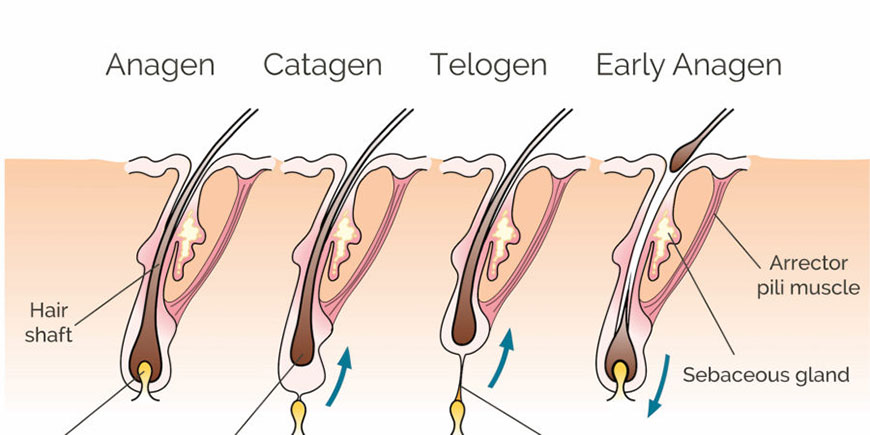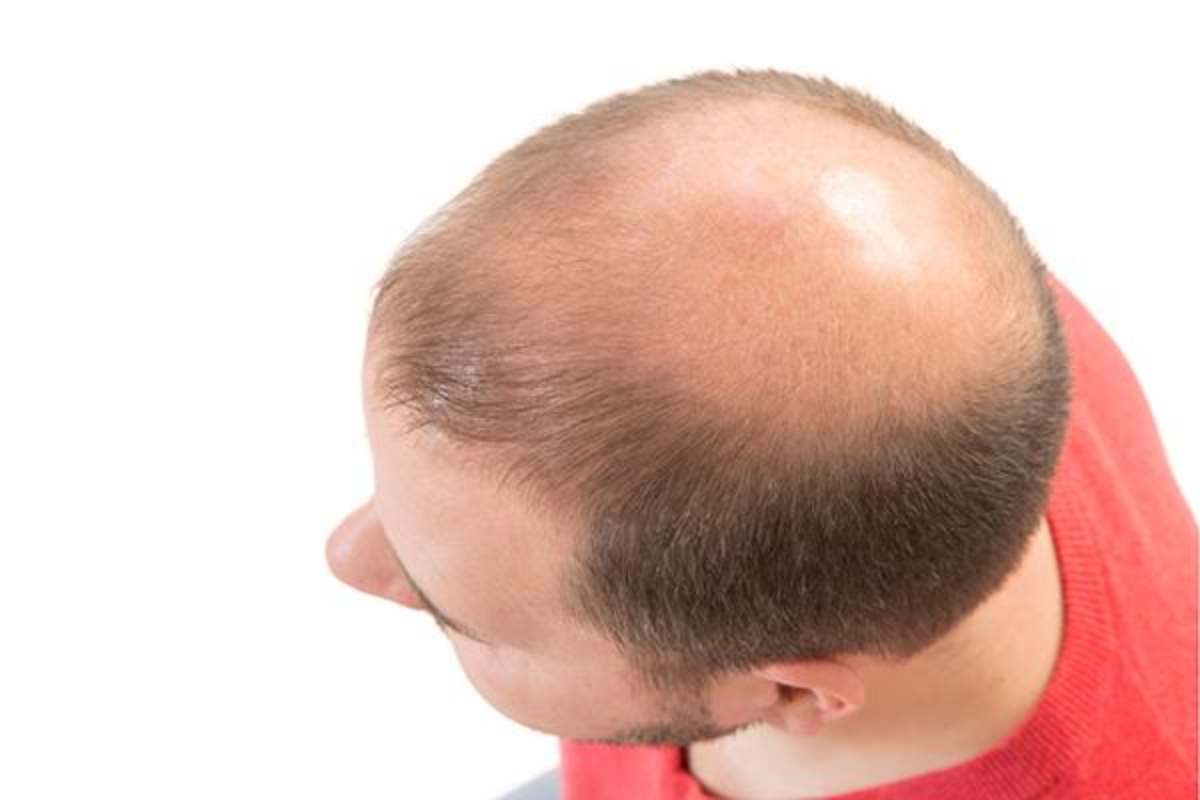With few exceptions, we all have hair. Everyday, we wash, brush, shave and sometimes obsess over our strands while taking for granted the fascinating process of hair growth—even if we often wish we could control it. No man welcomes that unruly nose or ear hair that appears with age and instead often wish for ample scalp, eyelashes, eyebrows or beards.
So how does our hair actually grow and where does the hair come from? It all starts within the millions of hair follicles located all over our bodies. According the American Academy of Dermatology, on average, approximately five million hair follicles are distributed across the entire body. About 100,000 of those hair follicles are on the scalp alone!
Let’s uncover exactly how these important, tiny organs create our hair.
What is a Hair Follicle?
Like all other mammals, hair follicles are found nearly everywhere on our bodies with only a few exceptions: the palms of our hands, soles of our feet and our lips.
We’re born with all of the hair follicles we’ll ever have. Every strand will continue to reproduce a new hair according to our genetics which send signals at different points in our life to either increase or cease production.
For example, some hairs don’t appear until puberty such as facial, underarm, and pubic hair. Though there are some medical procedures, health conditions and medications that can change where or how our follicles create hair, there’s no magic pill that can create new hair follicles.
In humans, each follicle produces one hair at a time. Hair itself has many different functions including temperature regulation, sensory perception and protection of sensitive body parts. Though perhaps not vital to survival of our species, hair in humans—and some animals like lions—are also believed to serve a function of beauty and mate attraction.
The Phases of Hair Growth

Before understanding how hair follicles work, it’s important to understand the three main phases of hair growth. These phases are:
The Anagen phase, or the growth phase, is the most active and the longest phase of the hair’s life cycle. About 90% of hairs are in this phase at any time.
This phase lasts several years for the scalp but only weeks to months on the rest of the body. That means that the length of your hair is determined by how long the follicle is in the anagen phase. This explains why some people are able to grow hair down past their waist while others may stop just below the shoulders.
The same is true for beards. Some people only have a little scruff, while others rival Duck Dynasty or ZZ Top. Also, the hair on our eyebrows, eyelashes, and legs have a shorter anagen phase which is why they grow much shorter.
The Catagen phase, or the transitional phase, typically lasts a few weeks. Though growth doesn’t end yet, it does begin slowing down. The dermal papilla and hair matrix (see parts of the hair follicle below) shrink as the growing hair follicle breaks away before shedding and then preparing to start producing a new hair.
The Telogen phase, or the resting phase, is the last phase of a hair’s life cycle. After a certain amount of time—depending on the hair’s location—growth will cease. The hair will eventually detach and shed as a new hair starts growing, pushing the old hair out.
Though it can depend on your genetics and age, on average, scalp hair grows about half an inch, or 1.3 cm, every month.
What Are the Main Parts of the Hair Follicle?
Hair follicles and small structures connected to the follicle are all essential to healthy hair development. The most important parts related to hair production include:
Dermal Papilla
Made up mostly of capillaries and connective tissues, this is the bulbous area at the base of every hair follicle. Blood vessels connect to the papilla and provide essential nutrients for healthy hair growth. The volume of the dermal papilla dictates the size and diameter of the hair shaft.
Hair Matrix
The hair matrix is wrapped around the papilla. This is where much of the cell division that builds the new hair structure happens.
Root or Bulb
As part of the actual hair, the root, also called the bulb, is at the very bottom of the shaft. The shape of the hair bulb changes as the follicle moves through the 3 stages of growth: anagen, catagen, telogen. Pluck out a growing hair and you’ll see a squiggly bulb with some tissue attached to it.
If you find a telogen hair on your shoulder, the bulb looks similar to the end of a Q-tip. In all hair colors, the bulb will be lighter than the hair itself. To the naked eye, the bulb will look like a little white ball on the end of your strand.
Bulge
Several stem cell varieties reside within the bulge. These stem cells help create new cells that ultimately create new hair. They can also create new pigment or epidermis when the surrounding skin is injured or diseased.
Arrector Pili
The arrector pili are small muscle fibers attached to the follicles. They pull the hair into a more upright position in response to certain stimuli like cold, stress, anger or fear. When you get chills or goosebumps and your hair stands up on end, that’s the arrector pili at work.
Subaceous Glands
The subaceous glands produce sebum—the oily substance that coats hair and skin which effects the texture and appearance. Sebum strengthens the hair, helps it glide out of the dermis as it emerges from the skin, provides suppleness to the surrounding skin and amplifies antimicrobial defenses.
Pigment Cells (Melanocytes)
Our hair color is created when pigment cells (melanocytes) transport melanosomes filled with melanin (actual pigment) into each strand of hair. As we grow older, the melanocytes stop producing pigment and begin to die. As melanin no longer integrates with the hair, it grows out as white. When mixed with colored strands, it appears as various shades of grey.
Nerve/Vascular Plexus
Did you know that hair is one of the most densely innervated organs of the body? Though not a true component of the hair follicle, each hair is surrounded by blood vessels and nerves that ensure our hair gets abundant access to nutrients, oxygen, bioregulatory molecules and neurotransmitters. Who would have guessed that a “simple” hair follicle was so darn complicated?!
Apocrine & Eccrine Glands
Sweat glands are not technically part of the hair follicle, but anatomically they are intertwined with most of the hairs on our body. They respond to some of the same neurotransmitters and hormones as our hair.
Apocrine glands are found where we have terminal hairs, while eccrine glands are found with both vellus and terminal hairs (see different kinds of hair follicles below). Apocrine secretions are the oily sweat that leads to body odor when mixed with bacteria on our skin. They start functioning at puberty.
Eccrine glands secrete watery sweat in response to emotional or thermal stimuli. This helps to regulate our body temperature throughout our lives. Along with stem cells residing in the bulge area of the hair follicle, the sweat glands also help repair the skin when it is injured.
What Are the Different Kinds of Hair Follicles?
By taking a quick look across your body, it’s easy to see that the texture, color, length, etc. of hair can change considerably.
For humans, the different forms our hairs take are separated by body areas. We have head hair, eyelash/eyebrow hair, limb hair on our arms and legs. When puberty strikes, you’ll see pubic hair, facial hair, and underarm hair, all of which look different from one another.
For example, scalp hair will stay in the anagen phase for years longer than eyebrow hair causing it to grow much longer. The same goes for eyelashes. Your body also tells eyelash hair follicles to make them shorter, thicker and stiffer than head hair so it can protect your sensitive eyes.
It’s also important to understand the difference between vellus hairs vs. terminal hairs. We are all born covered with vellus hair, which are the light, fine “peach fuzz” hairs that cover the majority of our bodies. Vellus hair covers almost the entire body up until puberty, when some vellus hair follicles transform into what are called terminal hairs.
Terminal hair is the darker, denser hair found on our heads and on post-pubescent bodies in areas like the armpits, pubic regions, face, etc.
When hair follicles shrink in size, causing the hair to look finer, it’s called miniaturization. This happens because of the production of a hormone called dihydrotestosterone or DHT. The hair follicle’s anagen phase also gets continually shorter. Men typically experience miniaturization more than women, though it occurs to both sexes.
When miniaturization occurs, the hair follicles transition from terminal to vellus, causing the hair to thin. Eventually, those follicles can become completely dormant. However, in some cases, it is possible for vellus hair follicles to turn into terminal hair and back again.
There are also notable racial differences in scalp hair. Hair from people of Asian descent typically have a very round shape on cross section. This makes it strong and more tolerant to damaging styling practices like bleaching, blow drying, and curling irons, but it is naturally very straight. The diameter of Caucasian hair can vary, but usually has more oval shaped and wavy strands. For those of African descent, hair will typically have a thinner ribbon-like shape on cross section. This creates a curlier texture but one that is the most easily damaged.
Exactly how hair is expressed on the body—and whether you can expect to keep growing it naturally your entire life—is all thanks to your genetics, your hormones and your very complex hair follicles.
Are your hair follicles starting to slow down or shutting down altogether? Whether you’re experiencing early signs of balding or have been dealing with hair loss for years, the experts at Limmer HTC in San Antonio, Texas will help you grow back the hair you love. Schedule an online appointment now or call us anytime at 210-496-9992.







